Mic 102 exam 1 questions Study guides, Class notes & Summaries
Looking for the best study guides, study notes and summaries about Mic 102 exam 1 questions? On this page you'll find 56 study documents about Mic 102 exam 1 questions.
Page 2 out of 56 results
Sort by
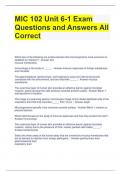
-
MIC 102 Unit 6-1 Exam Questions and Answers All Correct
- Exam (elaborations) • 6 pages • 2023
-
Available in package deal
-
- $10.49
- + learn more
MIC 102 Unit 6-1 Exam Questions and Answers All Correct Which two of the following are surface barriers that microorganisms must overcome to establish an infection? - Answer-skin mucous membranes Immunology is the study of _____. - Answer-immune responses to foreign substances and microbes The gastrointestinal, genitourinary, and respiratory tracts are internal structures connected with the environment, and are lined with _____. - Answer-mucous membranes The outermost layer of human...
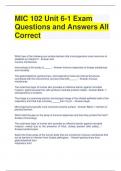
-
MIC 102 Unit 6-1 Exam Questions and Answers All Correct
- Exam (elaborations) • 6 pages • 2024
-
Available in package deal
-
- $13.49
- + learn more
MIC 102 Unit 6-1 Exam Questions and Answers All Correct Which two of the following are surface barriers that microorganisms must overcome to establish an infection? - Answer-skin mucous membranes Immunology is the study of . - Answer-immune responses to foreign substances and microbes The gastrointestinal, genitourinary, and respiratory tracts are internal structures connected with the environment, and are lined with . - Answer-mucous membranes The outermost layer of human skin provid...
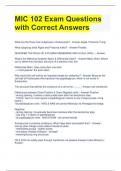
-
MIC 102 Exam Questions with Correct Answers
- Exam (elaborations) • 17 pages • 2023
-
Available in package deal
-
- $13.99
- + learn more
MIC 102 Exam Questions with Correct Answers What are the three main subgroups of Eukaryotes? - Answer-Algae, Protozoa, Fungi What subgroup does Algae and Protozoa make? - Answer-Protists DESCRIBE THE ROLE OF A PLASMA MEMBRANE AND A CELL WALL. - Answer- What's the difference between Basic & Differential Stain? - Answer-Basic Stain: Allows you to determine the basic structure of a bacteria (rod, etc) Differential Stain: Uses more than one stain --> most popular: the gram stain. ...
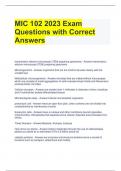
-
MIC 102 2023 Exam Questions with Correct Answers
- Exam (elaborations) • 12 pages • 2023
-
Available in package deal
-
- $14.49
- + learn more
MIC 102 2023 Exam Questions with Correct Answers transmission electron microscope (TEM) preparing specimens - Answer-transmission electron microscope (TEM) preparing specimens Microorganisms - Answer-organisms that are too small to be seen clearly with the unaided eye Multicellular microorganisms - Answer-microbes that are visible without microscopes which are consists of small aggregations of cells example bread molds and filamentous photosynthetic microbes Cellular microbes - Answ...
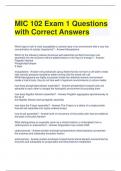
-
MIC 102 Exam 1 Questions with Correct Answers
- Exam (elaborations) • 6 pages • 2024
-
Available in package deal
-
- $13.29
- + learn more
MIC 102 Exam 1 Questions with Correct Answers Which type of cell is most susceptible to osmotic lysis in an environment with a very low concentration of solutes (hypotonic)? - Answer-Mycoplasma Which of the following cellular structures self-assemble (purified monomers can assemble into the structure without added factors or the input of energy)? - Answer- Flagellar filament Phospholipid bilayer S layer mycoplasma - Answer-only prokaryotic group listed that do not have a cell wall to res...
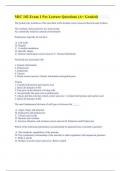
-
MIC 102 (100% Correct Answers)
- Package deal • 5 items • 2023
-
- $25.48
- + learn more
MIC 102 - Pre-Lecture Quizzes (All Answered Correctly) MIC 102 Exam 1 Pre Lecture Questions (A+ Graded) MIC 102 Exam 1 (with Complete Solutions) Mic 102 - Quizzes/Clickr (All Correct) MIC 102 UC Davis (100% Correct Answers)
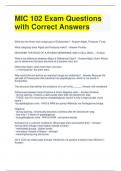
-
MIC 102 Exam Questions with Correct Answers
- Exam (elaborations) • 17 pages • 2024
-
Available in package deal
-
- $13.39
- + learn more
MIC 102 Exam Questions with Correct Answers What are the three main subgroups of Eukaryotes? - Answer-Algae, Protozoa, Fungi What subgroup does Algae and Protozoa make? - Answer-Protists DESCRIBE THE ROLE OF A PLASMA MEMBRANE AND A CELL WALL. - Answer- What's the difference between Basic & Differential Stain? - Answer-Basic Stain: Allows you to determine the basic structure of a bacteria (rod, etc) Differential Stain: Uses more than one stain --> most popular: the gram stain. ...

-
MIC 102 2023 Exam Questions with Correct Answers
- Exam (elaborations) • 17 pages • 2023
-
Available in package deal
-
- $10.49
- + learn more
MIC 102 2023 Exam Questions with Correct Answers transmission electron microscope (TEM) preparing specimens - Answer-transmission electron microscope (TEM) preparing specimens Microorganisms - Answer-organisms that are too small to be seen clearly with the unaided eye Multicellular microorganisms - Answer-microbes that are visible without microscopes which are consists of small aggregations of cells example bread molds and filamentous photosynthetic microbes Cellular microbes - Answe...
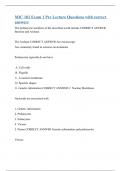
-
MIC 102 Exam 1 Pre Lecture Questions with correct answers
- Exam (elaborations) • 14 pages • 2023
- Available in package deal
-
- $14.49
- + learn more
The prokaryotic members of the microbial world include CORRECT ANSWER Bacteria and Archaea The Archaea CORRECT ANSWER Are microscopic Are commonly found in extreme environments Prokaryotes typically do not have A. Cell walls B. Flagella C. A nuclear membrane D. Specific shapes E. Genetic information CORRECT ANSWER C. Nuclear Membrane Nucleoids are associated with 1. Genetic information 2. Prokaryotes 3. Eukaryotes 4. Viruses 5. Prions CORRECT ANSWER Genetic infor...
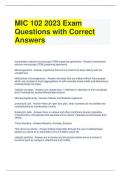
-
MIC 102 2023 Exam Questions with Correct Answers
- Exam (elaborations) • 12 pages • 2024
-
Available in package deal
-
- $13.49
- + learn more
MIC 102 2023 Exam Questions with Correct Answers transmission electron microscope (TEM) preparing specimens - Answer-transmission electron microscope (TEM) preparing specimens Microorganisms - Answer-organisms that are too small to be seen clearly with the unaided eye Multicellular microorganisms - Answer-microbes that are visible without microscopes which are consists of small aggregations of cells example bread molds and filamentous photosynthetic microbes Cellular microbes - Answer-...

How much did you already spend on Stuvia? Imagine there are plenty more of you out there paying for study notes, but this time YOU are the seller. Ka-ching! Discover all about earning on Stuvia


